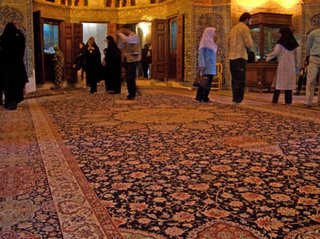 The floor of the shrine to Sheikh Safi od-Din in Ardebil, northwest Iran, is covered with a reproduction of the most famous carpet in the world - the Ardebil Carpet.
The floor of the shrine to Sheikh Safi od-Din in Ardebil, northwest Iran, is covered with a reproduction of the most famous carpet in the world - the Ardebil Carpet. Facts about the Ardebil Carpet
- Originally woven as a pair in either 1540 or 1586 making it one of the oldest carpets still in existence.
- The carpets were commissioned by Shah Tahmasp (1514-1576) who ruled Iran from the age of 10. They would have taken about 4 years to complete.
- They covered the floor of the Sheikh Safi Shrine for 3 centuries before being bought by a British traveller in 1890.
- They each measure 10.5m by 5m and contain some 30 million knots.
- The lamps at either end of the design are different sizes to create an illusion of perspective – this is because they were intended to be viewed primarily from one side.
- The 19th century British designer and socialist William Morris called it "the finest eastern carpet I have seen". It was he who persuaded the Victoria & Albert Museum and public donors to raise £2,000 to purchase it – at the time an enormous sum.
- It is thought that the V&A Ardebil was restored using parts of its twin.
- The V&A carpet has recently been laid on the floor for the first time in over a century as the centerpiece of the new Jameel Gallery of Islamic art. The room in which it is displayed is fully lit for only 10 minutes every half hour.
- The sister carpet was purchased in 1931 by J. Paul Getty who later donated it to the Los Angeles County Museum of Art.
- Modern carpet weavers were paid 100,000,000 Tomans to reproduce it for display at the Ardebil Shrine.
- There is a copy of the Ardebil carpet in 10 Downing Street and Adolf Hitler had a copy in his Berlin office.
- Both of the original carpets are signed and dated with an ode by the 14th century poet Hafez:-
My head has no resting place other than this doorway
© Iranvisitor.com

No comments:
Post a Comment